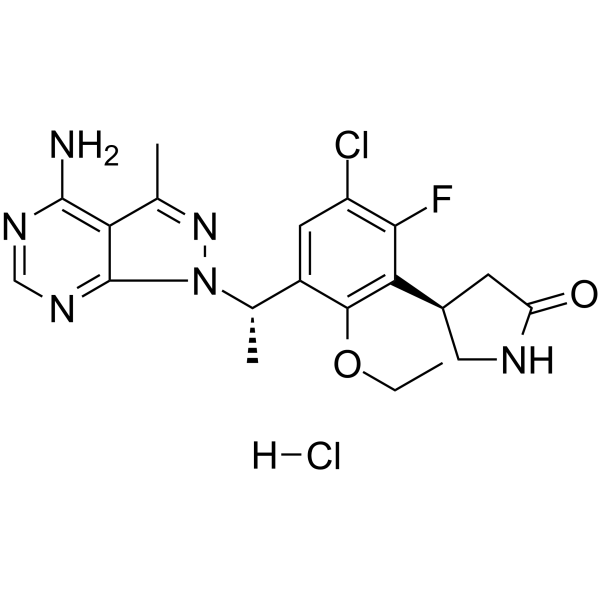Parsaclisib hydrochloride (Synonyms: INCB050465 hydrochloride) |
| Catalog No.GC62593 |
Parsaclisib hydrochloride (INCB050465 hydrochloride) is a potent, selective and orally active inhibitor of PI3Kδ, with an IC50 of 1 nM at 1 mM ATP. Parsaclisib hydrochloride shows approximately 20000-fold selectivity over other PI3K class I isoforms. Parsaclisib hydrochloride can be used for the research of relapsed or refractory B-cell malignancies.
Products are for research use only. Not for human use. We do not sell to patients.

Cas No.: 1995889-48-9
Sample solution is provided at 25 µL, 10mM.
Parsaclisib hydrochloride (INCB050465 hydrochloride) is a potent, selective and orally active inhibitor of PI3Kδ, with an IC50 of 1 nM at 1 mM ATP. Parsaclisib hydrochloride shows approximately 20000-fold selectivity over other PI3K class I isoforms. Parsaclisib hydrochloride can be used for the research of relapsed or refractory B-cell malignancies[1][2][3].
Parsaclisib (0.1-3000 nM; 4 d) inhibits proliferation of MCL and DLBCL cell lines[2].Parsaclisib (0.1-1000 nM; 2 h) inhibits anti-IgM-induced pAKT (Ser473) in the Ramos Burkitt’s lymphoma cell line, with an IC50 of 1 nM[2].Parsaclisib inhibits the proliferation of human, dog, rat, and mouse primary B cells after activation of these receptors, with IC50s ranging from 0.2 to 1.7 nM[2].
Parsaclisib (10 mg/kg; oral gavage twice daily for 7-19 days) inhibits tumor growth in the BALB/c mice bearing the A20 murine lymphoma cells[2].Parsaclisib (0.1-10 mg/kg; p.o. twice daily) slows Pfeiffer xenograft tumor growth in a dose-dependent manner. And Parsaclisib was well tolerated[2].Parsaclisib (0.5-1 mg/kg; a single p.o.) inhibits pAKT (Ser473) in Pfeiffer subcutaneous mouse xenograft models[2].
[1]. Shin N, et al. Abstract 2671: INCB050465, a novel PI3Kδ inhibitor, synergizes with PIM protein kinase inhibition to cause tumor regression in a model of DLBCL. Cancer Research. 2015, Aug. 75(15).
[2]. Shin N, et, al. Parsaclisib Is a Next-Generation Phosphoinositide 3-Kinase δ Inhibitor with Reduced Hepatotoxicity and Potent Antitumor and Immunomodulatory Activities in Models of B-Cell Malignancy. J Pharmacol Exp Ther. 2020 Jul;374(1):211-222.
[3]. Yue EW, et, al. INCB050465 (Parsaclisib), a Novel Next-Generation Inhibitor of Phosphoinositide 3-Kinase Delta (PI3Kδ). ACS Med Chem Lett. 2019 Oct 17;10(11):1554-1560.
Average Rating: 5 (Based on Reviews and 10 reference(s) in Google Scholar.)
GLPBIO products are for RESEARCH USE ONLY. Please make sure your review or question is research based.
Required fields are marked with *




















